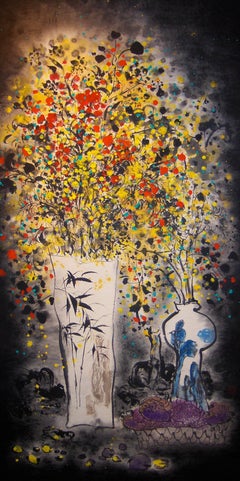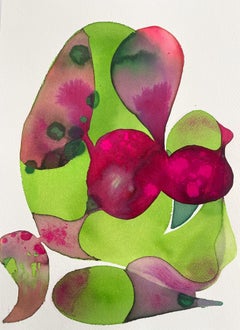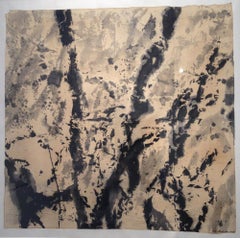Xiao Shunzhi Art
to
1
Overall Width
to
Overall Height
to
1
1
1
1
1
1
9,479
2,688
1,375
1,361
1
Artist: Xiao Shunzhi
"Sweet Flower Soliloquy #4" Chinese still life in yellow, red, blue and black
By Xiao Shunzhi
Located in Edgartown, MA
Chinese still life in yellow, red, blue and black.
The tradition of art is continuous: past creations are tradition for today, and today's creation will be future traditions. Trad...
Category
21st Century and Contemporary Abstract Xiao Shunzhi Art
Materials
Paper, Ink
Related Items
Flow
Located in San Francisco, CA
Paula Valenzuela
Flow, 2025
Watercolor, alcohol and acrylic ink on paper
14 x 10 inches
This one-of-a-kind work on paper comes unframed and ships in a tube. External, visible frame ...
Category
21st Century and Contemporary Abstract Xiao Shunzhi Art
Materials
Paper, Ink, Watercolor
Untitled
By Zao Wou-Ki
Located in PARIS, FR
A magnificent work in Indian ink and "levi" ink, counter glued on strong paper and accompanied by a certificate from the Zao Wou-Ki Foundation.
Zao Wou-Ki was born in Beijing on 1 F...
Category
1990s Abstract Xiao Shunzhi Art
Materials
India Ink, Rice Paper
Botanical Experiment #1
Located in San Francisco, CA
Paula Valenzuela
Botanical Experiment #1, 2025
Alcohol and watercolor inks on Yupo paper
14 x 11 inches
This one-of-a-kind work on paper comes unframed and ships in a tube. External...
Category
21st Century and Contemporary Abstract Xiao Shunzhi Art
Materials
Paper, Ink, Watercolor
Early Constructions no. 21
Located in London, GB
Toni LaSelle (1901–2002) was a pioneering American modernist and a key figure in shaping
modern art education in the United States. Strongly influenced by European movements such as ...
Category
Mid-20th Century Abstract Xiao Shunzhi Art
Materials
Paper, Oil Pastel, Ink
Original abstract butterfly drawing by easily searchable artist Steve McElroy.
By Steve McElroy
Located in Dallas, TX
This artist's butterfly work is in the current Veranda Magazine with Jan Showers.
"Butterfly" original drawing on French papers, framed in a handmade color coordinated frame. The m...
Category
2010s Abstract Xiao Shunzhi Art
Materials
Paper, Ink
$1,500
H 40 in W 30 in D 2 in
Untitled
By Franz Kline
Located in Beverly Hills, CA
Provenance:
Marlborough Gallery
David McKee, Inc.
Manny Silverman Gallery
Private collection, Los Angeles
Category
1950s Abstract Expressionist Xiao Shunzhi Art
Materials
Paper, Ink
Brains 1914
Located in New York, NY
Julie Harrison is an artist in New York City who moves between drawing, photography, video, painting, and performance.
Museum exhibitions include the Museum of Modern Art in New Yor...
Category
2010s Abstract Xiao Shunzhi Art
Materials
Paper, Printer's Ink, India Ink, Graphite
Metamorfosis
Located in San Francisco, CA
Paula Valenzuela
Metamorfosis, 2025
Watercolor and ink on paper
14 x 10 inches
This one-of-a-kind work on paper comes unframed and ships in a tube. External, visible frame and glass...
Category
21st Century and Contemporary Abstract Xiao Shunzhi Art
Materials
Paper, Ink, Watercolor
Black Holes & Wormholes - Red Orange
Located in New York, NY
Cosmology
"I am fascinated by abstract theories and hypothetical ideas in physics, especially in cosmology, which is the science of the universe’s origin, its evolution and its even...
Category
2010s Abstract Xiao Shunzhi Art
Materials
Paper, Ink, Pen
Black Holes & Wormholes - Blue Green
Located in New York, NY
Cosmology
"I am fascinated by abstract theories and hypothetical ideas in physics, especially in cosmology, which is the science of the universe’s origin, its evolution and its even...
Category
2010s Abstract Xiao Shunzhi Art
Materials
Paper, Ink, Pen
Brains 1809
Located in New York, NY
Julie Harrison is an artist in New York City who moves between drawing, photography, video, painting, and performance.
Museum exhibitions include the Museum of Modern Art in New Yor...
Category
2010s Abstract Xiao Shunzhi Art
Materials
Paper, Printer's Ink, India Ink, Graphite
Time Crystals - Square, 2023
Located in New York, NY
Cosmology
"I am fascinated by abstract theories and hypothetical ideas in physics, especially in cosmology, which is the science of the universe’s origin, its evolution and its even...
Category
2010s Abstract Xiao Shunzhi Art
Materials
Paper, Ink, Pen
Previously Available Items
"Flower Solioquy #7" Chinese abstract still life red, turquoise, blue and black
By Xiao Shunzhi
Located in Edgartown, MA
Chinese abstract still life red, turquoise, blue and black
The tradition of art is continuous: past creations are tradition for today, and today's creation will be future tradition...
Category
21st Century and Contemporary Abstract Xiao Shunzhi Art
Materials
Paper, Ink
Xiao Shunzhi art for sale on 1stDibs.
Find a wide variety of authentic Xiao Shunzhi art available for sale on 1stDibs. You can also browse by medium to find art by Xiao Shunzhi in ink, paper and more. Much of the original work by this artist or collective was created during the 21st century and contemporary and is mostly associated with the abstract style. Not every interior allows for large Xiao Shunzhi art, so small editions measuring 71 inches across are available. Customers who are interested in this artist might also find the work of Julia Zanes, Lloyd Raymond Ney, and Irene Rice Pereira. Xiao Shunzhi art prices can differ depending upon medium, time period and other attributes. On 1stDibs, the price for these items starts at $10,000 and tops out at $10,000, while the average work can sell for $10,000.


